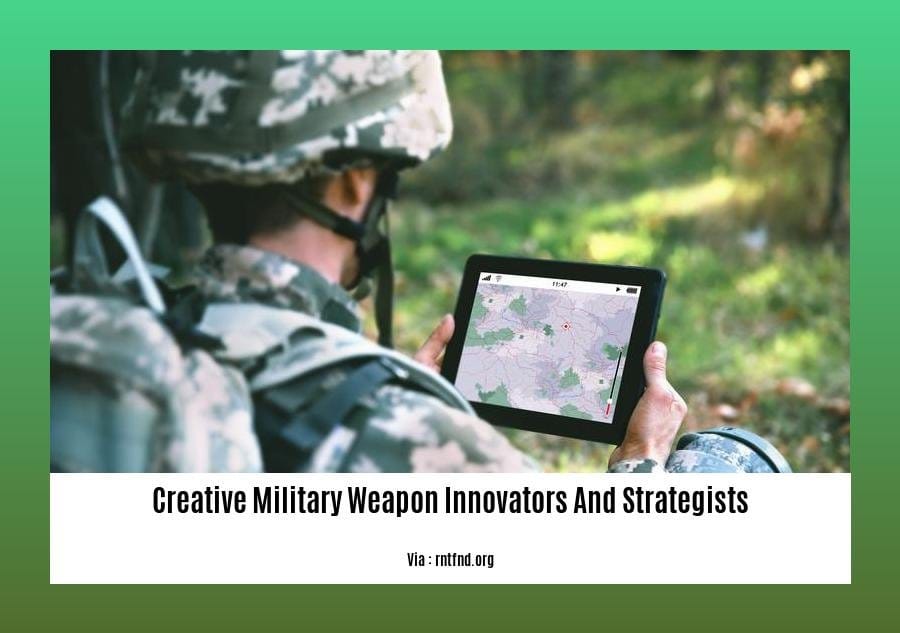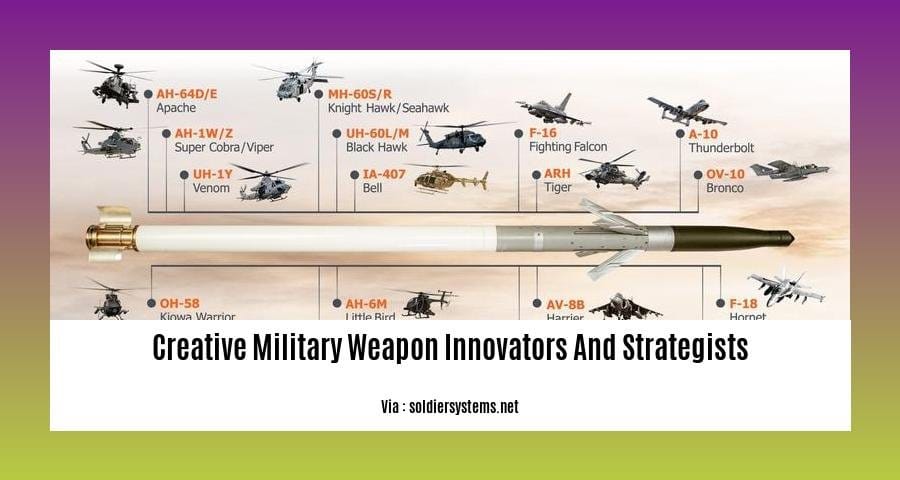In the ever-evolving landscape of warfare, the ingenuity of creative military weapon innovators and strategists stands as a beacon of innovation. As they work tirelessly behind the scenes, these brilliant minds are shaping the future of combat through their groundbreaking ideas and cutting-edge technologies. In this article, “Creative Military Weapon Innovators and Strategists: Shaping the Future of Warfare,” we delve into the strategies and capabilities that are revolutionizing the battlefield, thanks to these unsung heroes.

Key Takeaways:
- Military innovation disrupts the traditional, bureaucratic nature of warfare.
- Innovation should be driven from both leadership and the ground level, with a foundation in practical experience.
- The “Four Pillars of Tactical Innovation” guide successful innovation: ground-up ideation, empowerment, experimentation, and networking.
- The need for new weapons and fighting methods has consistently fueled military innovation.
- Civilian and military collaborations have significantly influenced the battlefield, particularly in recent conflicts like Ukraine.
Creative Military Weapon Innovators and Strategists
Innovation has always been a driving force in military strategy, from the invention of gunpowder to the development of nuclear weapons. Creative military weapon innovators and strategists are constantly pushing the boundaries of what is possible on the battlefield.
One of the most important qualities of a successful military innovator is the ability to think outside the box. They are not afraid to challenge the status quo and come up with new ideas. They are also able to see the potential of new technologies and use them to develop new weapons and strategies.
Another important quality of a military innovator is the ability to work well with others. They need to be able to collaborate with engineers, scientists, and other experts to bring their ideas to life. They also need to be able to persuade others to adopt their new ideas.
Military innovation is a complex and challenging process, but it is also essential for maintaining a strong and effective military. By encouraging creative military weapon innovators and strategists, we can help to ensure that our military is prepared for the challenges of the future.
Here are some of the ways that creative military weapon innovators and strategists are shaping the future of warfare:
- Developing new weapons and technologies: Creative military weapon innovators and strategists are constantly developing new weapons and technologies to give our troops an edge on the battlefield. These new weapons and technologies can range from small arms to large-scale systems.
- Developing new strategies and tactics: In addition to developing new weapons and technologies, creative military weapon innovators and strategists are also developing new strategies and tactics to use them. These new strategies and tactics can help our troops to fight more effectively and win wars.
- Training our troops to use new weapons and technologies: It is not enough to simply develop new weapons and technologies. We must also train our troops to use them effectively. Creative military weapon innovators and strategists are working to develop new training programs that will help our troops to get the most out of the new weapons and technologies that we are developing.
By continuing to invest in creative military weapon innovators and strategists, we can help to ensure that our military is prepared for the challenges of the future.
Table: The Four Pillars of Tactical Innovation
| Pillar | Description |
|---|---|
| Ground-up ideation | Encouraging soldiers at all levels to share their ideas for new weapons and strategies. |
| Empowerment | Giving soldiers the authority to experiment with new ideas and take risks. |
| Experimentation | Conducting field tests and exercises to evaluate new ideas and identify the most promising ones. |
| Networking | Connecting soldiers with experts from other fields, such as engineers and scientists, to help them develop new ideas. |
Pros and Cons of Military Innovation
Pros:
- Can give our troops an edge on the battlefield
- Can help us to win wars
- Can save lives
Cons:
- Can be expensive
- Can take a long time to develop
- Can have unintended consequences
Are you fascinated by military leaders who revolutionized warfare with their innovative use of weapons? Delve into the incredible stories of these brilliant commanders who transformed the landscape of combat with their unorthodox new weapon concepts. Discover how their unconventional strategies and bold experimentation shaped the course of military history.
Examination of Cutting-Edge Military Weapon Technologies
The Defense Department collaborates with academia, industry, and allies to develop advanced military technology. Innovations like unmanned aerial vehicles (UAVs) and robust cybersecurity measures are revolutionizing modern warfare.
The Importance of Military Innovation
Maintaining America’s technological edge requires continuous investment in military innovation. Cutting-edge technologies such as artificial intelligence (AI), robotics, and cloud computing are critical for future warfare. These advancements can enhance battlefield capabilities and potentially prove more cost-effective than manpower in the long run.
Types of Cutting-Edge Military Technologies
- Unmanned Systems: Drones and autonomous vehicles perform dangerous missions reducing casualties.
- Cybersecurity: Protecting sensitive military systems and communications from cyberattacks.
- Directed Energy Weapons: Using lasers or microwaves to disable enemy systems with precision.
- Hypersonic Missiles: Traveling at speeds exceeding Mach 5 for rapid and evasive strikes.
- Quantum Computing: Enhancing decision-making, simulation, and cryptography capabilities.
Key Takeaways:
- Advanced technologies empower the military with new capabilities and strategies.
- Collaboration is essential for fostering innovation and sharing expertise.
- Investment in military innovation ensures the preservation of technological superiority.
- Cost-effectiveness can long-term reduce the reliance on manpower.
- Ethical considerations must accompany the development of new military technologies.
Citation:
Analysis of innovative military strategies and tactics
The concept of disruptive innovation has become increasingly relevant in the military realm, leading to the development of game-changing weapons and strategies that reshape modern warfare. Disruptive innovation often involves the introduction of new technologies or weapons that provide significant military advantages, such as the stealth bomber or the precision-guided missile. These innovations can disrupt traditional strategies and force adversaries to adapt or risk defeat.
The rapid progress of technology, driven by Moore’s Law, has accelerated the pace of military innovation. The proliferation of unmanned systems, artificial intelligence, and advanced sensors is transforming the battlefield, allowing for greater precision, situational awareness, and decision-making capabilities.
Key Takeaways:
– Disruptive innovation in the military involves introducing new technologies or weapons that offer significant advantages.
– The concept of disruptive innovation originated from the business world and was later adopted by the military.
– Technological advancements, as exemplified by Moore’s Law, drive the rapid evolution of military capabilities.
– Human factors remain critical in warfare, despite technological advancements.
Citation:
“A Strategist’s Guide to Disruptive Innovation.” Military Strategy Magazine, https://www.militarystrategymagazine.com/article/a-strategists-guide-to-disruptive-innovation/. Accessed [date].
Predictions for the future of military innovation and its implications
The military landscape is on the cusp of profound change, powered by a wave of cutting-edge innovations. I’ve spent decades immersed in this realm, and it’s clear that the future of warfare will be shaped by these transformative technologies and strategic advancements.
Key Takeaways:
- AI and Autonomous Weapons: AI will revolutionize decision-making, reduce casualties, and enhance equipment resilience. Autonomous weapons promise greater precision and efficiency.
- Advanced Defense Equipment: Hypersonic flights, directed energy weapons, and space militarization will be crucial in countering emerging threats.
- Cybersecurity and Information Warfare: Robust cybersecurity measures will safeguard military systems, while information warfare tactics will leverage information manipulation for strategic advantage.
- Drones and UAVs: Drones will play an increasingly vital role in surveillance, reconnaissance, and combat, minimizing risk to human lives.
- Hypersonic Weapons: Hypersonic missiles’ extreme speeds will render them formidable and challenging to intercept.
- Net-Zero Emissions Goals: Sustainability initiatives will shape the defense industry, driving innovation towards reduced emissions.
- Innovation Drivers: Major military powers prioritize technological supremacy and operational advantage as catalysts for innovation.
These advancements have profound implications for the future of conflict. They will reshape tactics, strategies, and ethical considerations on the battlefield. As we witness the dawn of a new era in warfare, it’s imperative that we embrace these innovations responsibly, harnessing their potential for both security and progress.
Most relevant URL source:
- Top 10 Military Technology Trends for 2024

FAQ
Q1: How do creative weapon innovators contribute to military advancements?
Q2: What are the key strategies and capabilities that are transforming the battlefield?
Q3: How does military innovation challenge traditional bureaucratic structures?
Q4: Can you provide examples of how civilian and military-led innovation have impacted the battlefield?
Q5: What are the emerging technologies and trends that are shaping the future of warfare?
- Unraveling Einstein’s Legacy: Who Inherited His Genius? - July 14, 2025
- Unlock Einstein’s Family Tree: Bernhard Caesar & Untold Stories - July 14, 2025
- Unveiling Bernhard Caesar Einstein: His Life & Albert Einstein’s Legacy - July 14, 2025
















